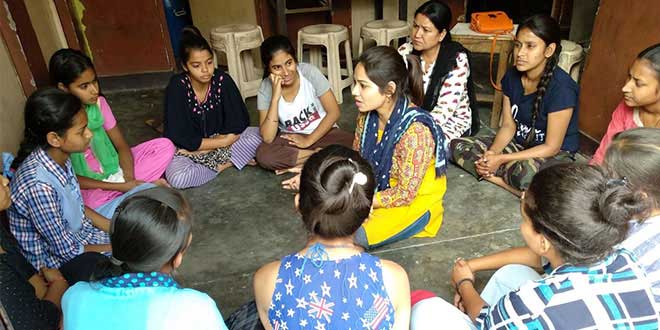( September 12, 2019 )

Through its project Swabhiman and support from Avery Dennison, NGO Smile Foundation has helped adolescent girls of Surat Nagar Phase 2, of Gurugram (erstwhile Gurgaon) overcome iron deficiency anaemia
New Delhi: In 2016, World Bank estimated that India loses 0.9 percent of GDP, amounting to a loss of up to $ 20.25 billion (RS.1.35 lakh crore) because of anaemia. The disease primarily caused by lack of essential nutrients like iron, vitamin B12 reduces the productivity of people it afflicts and in extreme cases can be fatal. In India, Anaemia is more prevalent among women (pregnant and non-pregnant) belonging to the age group of 15-49 years when compared to men of the same age group. 53.1 per cent of women were found to be Anaemic in National Family Health Survey (NFHS) 4 of 2015-16, as opposed to 22.7 per cent of men who were Anaemic.
A small effort to improve the health of 100 adolescent girls by controlling iron deficiency (anaemia) in the selected community of Surat Nagar Phase 2 Gurugram (erstwhile Gurgaon) was initiated by a Delhi based NGO Smile Foundation and adhesive manufacturing company in January this year.
he project was introduced under Smile Foundation’s umbrella project Swabhiman instigated in 2005 to make a difference to the status of women’s health. Giving out details of the Swabhiman project, Seema Kumar, project lead, says, “Unfortunately, far from being empowered, most women are denied even their basic rights like health, education, employment and a respectable status in the society. To address these challenges, a tailor-made strategy called the ‘4 S Model’ has been developed under Swabhiman (self-respect) project.
Identification Of The Target Group
Over the years, Gurugram, known as the financial and technological hub, has witnessed a rise in the number of migrant labour, moving into the city for work. The demographic study of the identified location revealed that it is dominated by underprivileged and gender-biased community where girls are often deprived of proper nutrition.
Through regular health check-ups, the prevalence of anaemia among the women and girls was noted. It is only then Smile Foundation and Avery Dennison decided to improve the health of 100 adolescent anaemic girls (10-19 years) through education and awareness.
Improving Iron Deficiency Anaemia In The Selected Community Of Surat Nagar Phase 2, Gurugram
In January 2019, when Haemoglobin (Hb) tests were done, on an average, Hb levels were recorded between 6-11 gm/dl (grams per decilitre) as opposed to ideal levels of 11-16 gm/dl among children. After six months, in June, another blood test was done and significant improvement in the Hb levels of the beneficiaries was recorded.
Among all the beneficiaries was a 15-year-old Sapna, working as a volunteer with Smile Foundation since 2018; who was diagnosed with anaemia during one of the health check-ups. Recalling the day and how her Hb levels improved in just six months, Sapna says,
“One day my mentor noticed my eyes and asked me to get a health check-up done because my eyes looked extra white. In January this year, I was diagnosed with anaemia and my Hb levels were recorded at 7 gm/dl (as opposed to the ideal Hb of minimum 11 gm/dl). I was given iron and folic acid supplements and asked me to inculcate nutritious food in my diet which majorly included add green leafy vegetables, milk, chick peas and jaggery. Back then I didn’t know how severe anaemia can be, let alone how to cure it.
After six months, in June, Sapna’s Hb level rose to commendable 8.5gm/dl. But the question here is, what motivated the 15-year-old girl and other adolescents to adopt healthy practices and diet and how did they do it.
To create awareness among girls and educate them about the health benefits of having adequate Hb levels, focus group discussions, group meetings, one on one counselling sessions, workshop with nutrition expert, and community medical doctor was organised.
Until and unless individuals are educated about the health implications of a particular disease, they take little to no preventive and corrective measures. Keeping that in mind, during all the discussions and workshops, various aspects of anaemia – symptoms, treatment and prevention, and nutritious diet were discussed. Talking about the same, Seema says,
“People residing in the rural region can’t afford luxurious or expensive nutritious food like red meat, fish, tofu, sea food, so we would suggest low cost nutritious food like lentils, sprouts, seasonal fruits and vegetables, and jaggery. We discussed good practices of cooking to preserve nutrients like steaming and boiling, nutritious and balanced diet (protein rich food like lentils, beans, seasonal fruits and vegetables, whole grains, iron and vitamin C rich food and dairy products) for overall development, among other things.
With education and expert guidance, the team managed to improve the Hb levels among the adolescent girls and within six months results started showing. Earlier, in January, the minimum Hb among the target group was 6gm/dl, but in June, it shot upto 8gm/dl. Also, before Smile Foundation’s intervention, only a couple of girls had Hb levels more than 9gm/dl, but today 82 girls have Hb levels at 9 and above.
“The adolescence period is an intense anabolic period when the requirements for all nutrients increases. The poor food habits, lack of resources and lack of nutritional awareness are considered to be the main factors in determining nutritional status. During the intervention period, we tried to change the poor food habits, and raise awareness about anaemia and how even poor people can have nutrients rich diet, says Seema Kumar.
Dangers Of Anaemia
Experts believe Anaemia can be acute to fatal. People with severe levels of Anaemia may face cardiac attack and can die due to complications. Pregnant women, if Anaemic, can witness impediments during delivery. Also, if a pregnant woman is anaemic, new born will also be anaemic which can hamper the child’s growth.
“Most of the people who have Anaemia have decreased capacity to work and are often breathless, they are less productive and can’t exert themselves. Even GDP contribution will be less from such people, suggests Dr Giridhara R Babu, Professor, Head Lifecourse Epidemiology, PHFI, Bangalore.
Information Gathering
1. Smile Foundation collects information from the users in a number of ways, for example when the user:
2. While forwarding a donation for Smile Foundation the well-wishers have to submit some personal information as it would help us ensuring genuine contributions:
3. Smile Foundation does not collect or record the user’s personal information unless he/she chooses to provide it.
Use of Personal Information
1. General browsing of Smile Foundation website is anonymous and it does not register the user’spersonal information except the time, date and place of visits and the name of internet service provider. This data is used only for statistics and diagnosis.
2. By signing up for various services offered by Smile Foundation, the user explicitly authorizes us to collect information based on the user’s usage. The information is used to help provide a better experience to the user and is used as per the user’s specified instructions.
3. Smile Foundation keeps the user information strictly confidential and this information is secured safely. All relevant information collected through Smile Foundation website is handled and used by internal and/or authorized officials only. It is nevershared with any external agencies or third party individuals.
4. Smile Foundation uses the information givento it in the following ways:
5. Usually, Smile Foundation does not store user data. In case of specific sign-ups, the data is stored as per user request. The user can opt to delete all the information he/she has provided by simply requesting such by mail. All information, without exception, will be deleted in two working days.
Privacy of e-mail lists
Individuals who join Smile Foundation’s mailing lists via its website or through its campaigning engagements are added to its email database. Smile Foundation does not sell, rent, loan, trade, or lease the addresses on our lists to anyone.
Cookie Policy
1. Cookies are pieces of electronic information which will be sent by Smile Foundation when a user visitsthe website. These will be placed in the hard disk of the user’s computer and enable Smile Foundation to recognise the user when he/she visits the website again.
2. The user can configure his/her browser so that it responds to cookies the way he/she deems fit. For example, you make want to accept all cookies, reject them all or get notified when a cookie is sent. The users may check their browser’s settings to modify cookie behaviour as per individual behaviour.
3. If a user disables the use of cookies on the web browser, or removes or rejects specific cookies from Smile Foundation’swebsite or linked sites then he/she may not be able to use the website as it is intended.
Payment Gateway
1. SmileFoundation uses well-recognised and proven technology for payments. Payment information is transferred by the use of an SSL connection which offers the highest degree of security that the donor’s browser is able to support.
2. Several layers of built-in security, including an advanced firewall system, encryption of credit card numbers, and use of passwords, protect the collected information.
External Web Services
1. Smile Foundation uses a number of external web services on its site to display content within its web pages. For example, to display video it uses YouTube. As with the social media buttons, Smile Foundation cannot prevent these sites, or external domains, from collecting information on the user’s consumption of the content embedded on its site.
2. The Smile Foundation website contains links to other websites for the benefit of its visitors. This Privacy Policy does not apply to such other websites.
3. Smile Foundation is not expressly or impliedly responsible for, or liable to any loss or damage caused to a user by the collection, use and retention of Personal Information by such website in any manner whatsoever. It is important that the users review the privacy policies of all websites they visit before disclosing any information to such websites.
Changes to Privacy Policy
1. As and when the need arises, Smile Foundation may alter its privacy policy in accordance with the latest technology and trends. It will provide you with timely notice of these changes. The users may reach out to Smile Foundation if they have any queries about any changes made to its practices.
2. If you have any questions at all about Smile Foundation’s privacy policy, please write to us at: info@smilefoundationindia.org
Welcome to this web-site of SMILE FOUNDATION. We make public our policy on refund and cancellation of donations received for the social cause on payment gateway as under:-
Use of this site is provided by SMILE FOUNDATION subject to the following Terms and Conditions:
SMILE FOUNDATION reserves the rights to change these terms and conditions at any time by posting changes online. Your continued use of this site after changes are posted constitutes your acceptance of this agreement as modified. You agree to use this site only for lawful purposes, and in a manner which does not infringe the rights, or restrict, or inhibit the use and enjoyment of the site by any third party.
This site and the information, names, images, pictures, logos regarding or relating to SMILE FOUNDATION are provided “as is” without any representation or endorsement made and without warranty of any kind whether express or implied. In no event will SMILE FOUNDATION be liable for any damages including, without limitation, indirect or consequential damages, or any damages whatsoever arising from the use or in connection with such use or loss of use of the site, whether in contract or in negligence.
SMILE FOUNDATION does not warrant that the functions contained in the material contained in this site will be uninterrupted or error free, that defects will be corrected, or that this site or the server that makes it available are free of viruses or bugs or represents the full functionality, accuracy and reliability of the materials.
Copyright restrictions:
Commercial use or publication of all or any item displayed is strictly prohibited without prior authorization from SMILE FOUNDATION. Nothing contained herein shall be construed as conferring any license by SMILE FOUNDATION to use any item displayed.
Documents may be copied for personal use only on the condition that copyright and source indications are also copied, no modifications are made and the document is copied entirely. However, some documents and photos have been published on this site with the permission of the relevant copyright owners (who are not SMILE FOUNDATION). All rights are reserved on these documents and permission to copy them must be requested from the copyright owners (the sources are indicated within these documents/photographs).
SMILE FOUNDATION takes no responsibility for the content of external Internet sites. Other websites that we link to are owned and operated by third parties and SMILE FOUNDATION has no control over them. The fact that we include links to other websites does not mean that SMILE FOUNDATION approves of or endorses any other third party website or the content of that website. We accept no liability for any statements, information, products or services that are published on or are accessible through any websites owned or operated by third parties.
Any communication or material that you transmit to, or post on, any public area of the site including any data, questions, comments, suggestions, or the like, is, and will be treated as, non-confidential and nonproprietary information. If there is any conflict between these terms and conditions and rules and/or specific terms of use appearing on this site relating to specific material then the latter shall prevail.
These terms and conditions shall be governed and construed in accordance with the laws of India.
If these terms and conditions are not accepted in full, the use of this site must be terminated immediately. SMILE FOUNDATION for Social Welfare Service is a registered at
161 B/4, 3rd Floor, Gulmohar House
Yusuf Sarai Community Centre
New Delhi-110049
Phone : +91-11-43123700

Sarva Shiksha Abhiyan
National Education Policy
Beti Bachao, Beti Padhao
Digital India

Skill India
Enhancing Formal Skilling

National Rural Health Mission
Universal Health Coverage
National Digital Health Mission
Promotion of Govt. Health Schemes

Anaemia Mukt Bharat
Poshan Abhiyan
Atmanirbhar Bharat Abhiyan
Anganwadi Strengthening